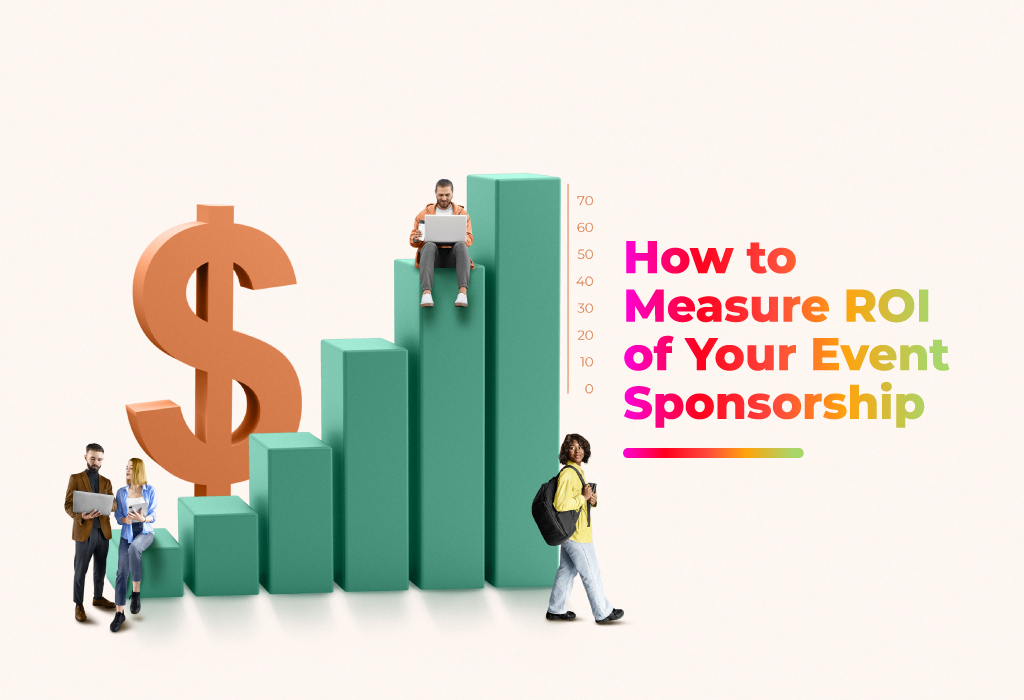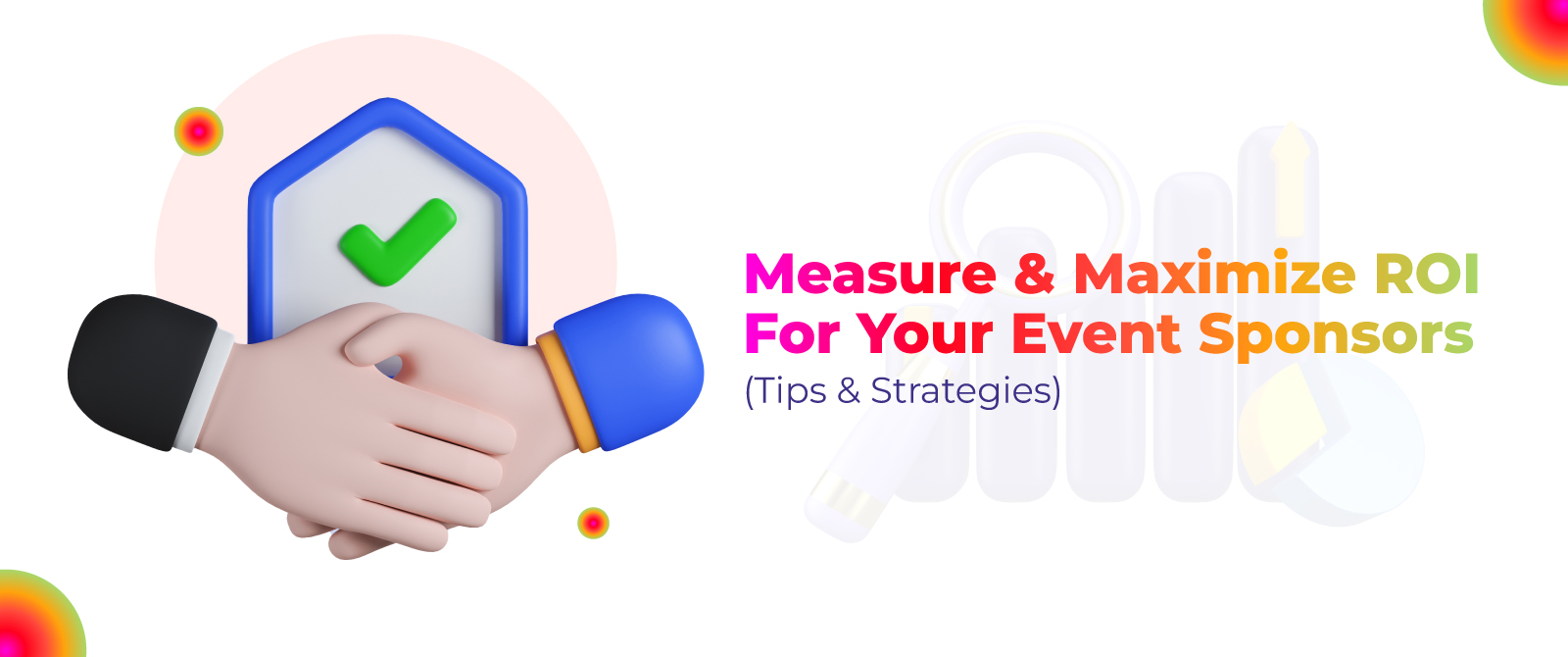To make event sponsorship successful, your sponsors expect to get the returns of their investment. If they can’t reach their desired returns, they would prefer to invest their money elsewhere. As the event planner, the best way to prove ROI to your event sponsors is to keep track of it and measure it.
Measuring ROI is so important that 40% of event professionals say it is one of the top two challenges to measure and evaluate sponsor ROI. So, it has to be your goal to let sponsors see the value of the sponsorship package in order to keep coming back to you year after year.
So, in this guide, we’ll explore key metrics to measure sponsorship ROI, and strategies to maximize it.
What Do Sponsors Look for in an Event

Sponsors look for specific attributes and opportunities when considering participating in an event. Understanding these factors can help event organizers attract and retain sponsors. Here are key elements that sponsors typically look for in an event:
Product Targeting Audience:
Sponsors want to reach a target audience that aligns with their products or services. Events that attract participants relevant to the sponsor’s industry or target market are more appealing. Event organizers should have a clear understanding of their attendee demographics and be able to demonstrate the relevance to potential sponsors.
Engagement Opportunities:
Sponsors seek meaningful opportunities to engage with event attendees. This can include speaking slots, interactive sessions, workshops, or sponsored activities that allow sponsors to showcase their expertise and products. The more engagement opportunities available, the more attractive the event becomes to sponsors.

Visibility and Brand Exposure:
Sponsors look for events that offer high visibility and extensive brand exposure. This includes prominent logo placement in marketing materials, signage, event websites, and virtual platforms. The visibility of sponsors before, during, and after the event is crucial for building brand awareness and recognition.
Innovative and Interactive Platforms:
In the case of virtual or hybrid events, sponsors are interested in an event networking platform that provides innovative and interactive experiences. Virtual booths, networking opportunities, and features that facilitate direct engagement with attendees are highly valued. The ability to showcase products or services in a dynamic virtual environment is essential.
Networking Opportunities:
Events that facilitate networking opportunities between sponsors and attendees are attractive. Sponsors are interested in building relationships and connections within the event community. Networking sessions, receptions, or matchmaking programs contribute to a positive sponsorship experience.
Positive Event Reputation:
Sponsors prefer events with a positive reputation and a track record of success. Testimonials, case studies, and references from previous sponsors can instill confidence. Event organizers should highlight past successes and showcase positive outcomes for sponsors.
Clear Communication and Collaboration:
Sponsors appreciate clear communication and collaborative planning. Transparent communication about sponsorship benefits, expectations, and deliverables helps build a strong relationship. Regular updates and collaboration throughout the event planning process contribute to a positive experience for sponsors.
Post-Event Opportunities:
Sponsors often seek opportunities for continued engagement after the event. This could include post-event content collaboration, access to attendee lists, or participation in follow-up activities that extend the impact of the sponsorship beyond the event itself.
How to Measure ROI of Your Event Sponsorship

1. Define Clear Objectives:
Before diving into measuring ROI, it’s essential to establish clear and specific objectives for your event sponsorship. These objectives should align with your overall marketing and business goals. Whether you aim to increase brand awareness, generate leads, or enhance customer engagement, having well-defined objectives will guide your measurement efforts.
2. Select Relevant Key Performance Indicators (KPIs):
Identify and select key performance indicators (KPIs) that directly align with your objectives. These could include metrics such as:
Brand Visibility: Measure the visibility of your brand during the event, including logo placements, signage, and mentions in event materials.
Lead Generation: Track the number and quality of leads generated through the event. This could involve collecting contact information, monitoring inquiries, or tracking engagement with promotional materials.
Social Media Engagement: Assess the impact of the event on your social media channels. Track metrics like impressions, likes, shares, and comments related to the event.
Customer Engagement: Measure the level of interaction and engagement with attendees during the event, such as booth visits, product demonstrations, or participation in activities.
Sales Conversions: If applicable, track the conversion of event-generated leads into actual sales using sales pipeline software. This technology can streamline the process, making it easier to monitor and manage follow-ups to determine the impact on your sales pipeline.
3. Establish a Baseline and Benchmark:
Before the event, establish a baseline for each selected KPI. This baseline serves as a reference point for comparison after the event. Additionally, research industry benchmarks to understand how your performance compares to industry standards. This comparison will provide context and help you determine whether your results are favorable.
4. Calculate ROI:
After the event, calculate the ROI by comparing the results against the pre-established benchmarks and the total costs incurred. The formula for ROI is [(Net Profit / Cost of Investment) x 100]. Consider both tangible and intangible benefits in your analysis.
5. Conduct Post-Event Analysis:
After the event, conduct a thorough analysis of the collected data. Compare the post-event results with the established baseline and industry benchmarks. Evaluate the success of the event sponsorship in achieving your objectives and assess the overall ROI. Take into account not only quantitative data but also qualitative insights, such as feedback from attendees and the impact on brand perception.
Strategies To Maximize ROI of Event Sponsors
Maximizing return on investment (ROI) for event sponsors is crucial for building long-term partnerships and attracting continued support. Here are strategies to help you maximize ROI for your event sponsors:
Clearly Define Sponsorship Packages:
Clearly outline and communicate sponsorship packages that offer different levels of exposure and benefits. This allows sponsors to choose a package that aligns with their goals and budget, ensuring a better fit between sponsor expectations and what the event can deliver.
Customize Sponsorship Opportunities:
Tailor sponsorship opportunities to meet the specific needs and objectives of each sponsor. Work closely with sponsors to understand their goals and create customized packages that provide the most value for their investment.
Provide Brand Visibility:
Offer sponsors prominent brand visibility both online and offline. This includes logo placement in event materials, signage, websites, social media, and any other promotional channels. Ensure that sponsors receive exposure to the target audience throughout the event.
Create Interactive Experiences:
Create interactive experiences that involve sponsors and attendees. This could include sponsored workshops, interactive booths, or engaging activities that promote direct interaction between sponsors and event participants.
Facilitate Networking Opportunities:
Provide sponsors with opportunities to connect directly with attendees through networking sessions, VIP events, or dedicated sponsor lounges. Facilitating these interactions enhances the sponsor’s visibility and fosters relationship-building with potential customers.
Measurable Metrics and Analytics:

Implement measurable metrics that sponsors can use to assess the success of their investment. This might include lead generation, website traffic, social media engagement, or other relevant KPIs. Sharing post-event analytics with sponsors demonstrates the impact of their participation.
Offer Data and Insights:
Provide sponsors with valuable data and insights gathered during and after the event. This could include attendee demographics, engagement statistics, and feedback. Equipping sponsors with meaningful information helps them understand the effectiveness of their sponsorship and informs their future marketing strategies.
Establish Long-Term Relationships:
Focus on building long-term relationships with sponsors rather than one-time transactions. Regularly communicate with sponsors, seek feedback, and explore ways to collaborate beyond the event. Long-term partnerships often lead to increased loyalty and continued support.
Value-Added Benefits:
Provide additional value-added benefits to sponsors, such as exclusive access to industry reports, early registration for future events, or participation in advisory boards. These extra perks enhance the overall sponsorship package and incentivize sponsors to continue their involvement.
FAQs
Sponsoring an event provides numerous benefits, including increased brand visibility, access to a targeted audience, opportunities for direct engagement, enhanced credibility, and the potential for lead generation and business growth.
Sponsorship opportunities can vary widely and include options such as logo placement, branded booths or spaces, sponsored sessions, networking events, virtual booths for online events, and promotional materials. Customizable packages are often attractive to sponsors with diverse goals and budgets.
Introducing sponsors at an event can be achieved through methods such as live announcements, dedicated sponsor sessions, or visually appealing slides displaying sponsor logos. It’s important to emphasize the value sponsors bring to the event and express gratitude for their partnership.
Measure the success of event sponsorship by tracking key performance indicators (KPIs) such as brand impressions, lead generation, social media engagement, and attendee satisfaction. Use analytics tools to provide sponsors with real-time data and conduct post-event surveys to gather feedback.
Foster positive relationships with sponsors by delivering on promised benefits, providing regular communication and updates, being responsive to their needs, and seeking feedback after the event. Consider post-event collaboration opportunities and demonstrate the value of an ongoing partnership.






